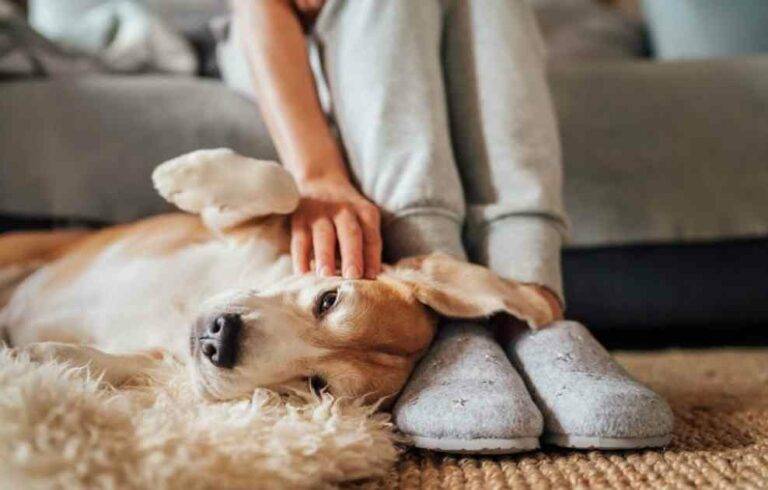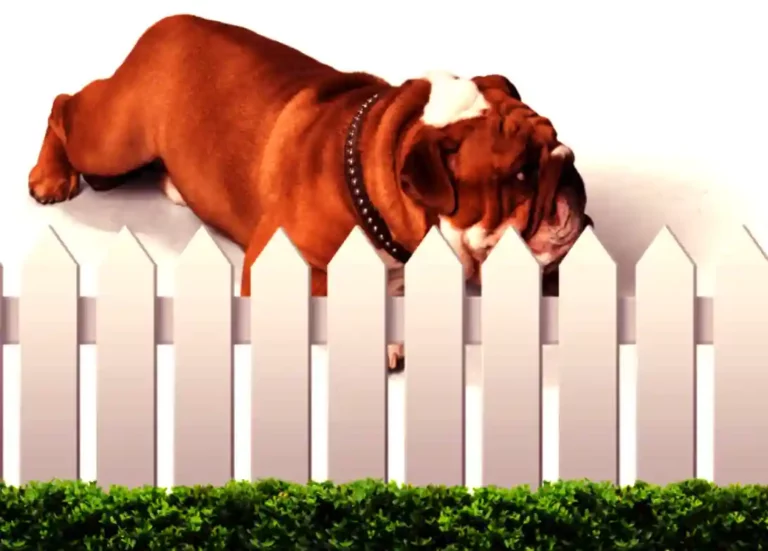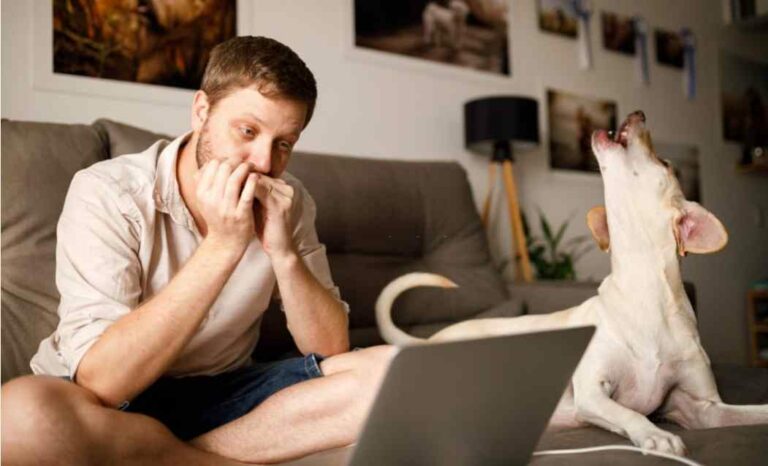Why Puppies Are Scared of Balloons
Puppies are known for their endless curiosity and playful behavior but are also incredibly sensitive. They are busy exploring the world and learning from their environment during their early developmental stages. So, it is crucial to identify that puppies do not view the world as adults do. Objects that seem harmless to us might appear entirely different to their innocent eyes.
Remember, the first few weeks of a puppy’s life are particularly critical. During this period, they form impressions about various stimuli, including balloons. A negative encounter with a balloon during this time can lead to fear imprinting, making the puppy associate balloons with danger for the rest of their life.
A puppy’s senses play a significant role in their perception of the world. Their acute sense of smell can detect balloons’ unique odors, which might be unfamiliar and disturbing. Additionally, seeing a large, floating object can be visually overwhelming for a small puppy, contributing to their fear.

While domesticated, puppies still retain instincts from their wild ancestors. The fear of sudden movements and unexpected sounds, such as balloons popping, is deeply rooted in their survival mechanisms. These instincts are designed to keep them safe from potential threats in the wild, and sometimes, balloons can unintentionally trigger these instincts.
Remember, puppies have sensitive hearing that allows them to detect a wide range of sounds. The range of sounds that puppies can hear is typically between 15 to 65,000 Hertz (Hz). Not only that, puppies can detect sounds as low as -5 to 15 decibels(dB).
Humans often project our emotions and thoughts onto animals, a phenomenon known as anthropomorphism. It is essential to understand that dogs have their own unique set of emotions and reactions. While we may not fully comprehend why a balloon evokes fear in them, we can still support and empathize with their experience.
So, to help puppies overcome their fear of balloons, we must foster an environment of safety, trust, and patience.
Table of Contents
- The Science Behind Dogs Scared of Balloons
- The Role of Genetics and Early Experiences
- Socializing Puppies to Face Balloon Phobia
- Building Confidence in Canines
- Comforting Your Fearful Furry Friend
- Conclusion
The Science Behind Dogs Scared of Balloons
Here, we will find the science behind canine fear and anxiety, shedding light on the physiological and psychological processes that occur when puppies encounter balloons. Understanding the science behind fear will allow us to approach the issue with a more informed and compassionate perspective.
The Amygdala: The Fear Center of the Brain
The amygdala, a small almond-shaped structure in the brain, plays a central role in processing emotions, especially fear. So, when a puppy encounters a balloon, sensory information is rapidly relayed to the amygdala, triggering fear responses and initiating the fight-or-flight reaction.
Neurotransmitters: The Messengers of Fear
Neurotransmitters are chemical messengers that facilitate communication between nerve cells in the brain. In the presence of a balloon, neurotransmitters associated with fear, such as adrenaline and cortisol, flood the puppy’s brain, heightening its sense of alertness and anxiety.
The Role of Hormones: Stress and Anxiety
Remember, Fearful encounters with balloons can elevate stress hormone levels in puppies, leading to prolonged anxiety. Chronic stress can harm a puppy’s overall well-being, impacting their physical health and emotional stability.
Conditioning and Associative Learning: Forming Fearful Links
When a puppy experiences fear in the presence of a balloon, it might form negative associations with the balloon itself and the environment or specific cues surrounding the event. These learned associations can contribute to the persistence of balloon phobia.
Genetics and Fear Predisposition
As puppy experts said, Genetics can also influence a puppy’s predisposition to fear and anxiety. Some breeds may be more likely to develop specific fears, including balloon phobia. However, it’s important to note that genetics is not the sole determining factor, and environmental experiences play a significant role.
The Impact of Early Socialization
Remember that early socialization, or the lack thereof, can significantly influence a puppy’s response to various stimuli, including balloons. Puppies with positive and varied experiences during their early weeks are more likely to develop confidence and resilience, making them less susceptible to fear and anxiety later in life. So, early socialization is needed for a puppy to grow up confidently.
The Plasticity of the Canine Brain: Opportunities for Healing
You might not know the pup brain exhibits neuroplasticity, which means it can change and adapt throughout a dog’s life. This incredible adaptability presents opportunities for rehabilitation and healing in fearful puppies. By providing positive experiences and structured desensitization, we can reshape their responses to balloons.
Emotions as Social Signals
Remember that fear is not an isolated emotional response but also a social signal. Observing a puppy’s fearful behavior can help us understand its emotional state and provide the appropriate support and reassurance.
Balloons as Triggers: Unraveling the Specifics
Beyond the general science of fear, we’ll explore why balloons, in particular, elicit such responses in puppies. From their appearance to the unique sounds they make, we’ll uncover the specific triggers that make balloons daunting for our furry friends.
So when understanding the science of canine fear is a crucial step in developing effective strategies to help puppies overcome their balloon phobia. With this knowledge, we can approach their fear with empathy and scientific precision, working towards fostering a calmer and more confident companion.
www.puppiesdiary.com
The Role of Genetics and Early Experiences

Nature: The Influence of Genetics
Always remember, Genetics can significantly impact a puppy’s temperament and predisposition to fear. Certain breeds may have genetic tendencies towards anxious behaviors, which can influence how they react to novel stimuli like balloons. However, genetics is not destiny, and it’s crucial to understand that early experiences play a crucial role.
Nurture: The Power of Early Experiences
Keep in your mind early experiences and socialization play a pivotal role in a puppy’s emotional development. So, positive encounters with balloons during their critical socialization period can shape a puppy’s perception, reducing the likelihood of developing fear later in life.
Fearful Parental Influence: A Possible Inheritance
Evidence suggests that puppies can inherit fearful tendencies from their parents. So, fearful parental behavior can create an environment where puppies learn to be cautious or anxious around certain stimuli, including balloons.
The Impact of Breeding and Puppy Mills
Puppies from irresponsible breeding or puppy mill backgrounds may have had limited socialization or exposure to various stimuli during their early weeks. As a result of it, they may be more prone to fear and anxiety, including balloon phobia.
Identifying Genetic Predisposition
Understanding whether a puppy comes from a breed with known fearful tendencies can help owners proactively approach training and socialization. Recognizing the potential for fear allows us to tailor interventions to suit the puppy’s needs.
Nature and Nurture: A Dynamic Relationship
The other thing is that nature and nurture are not mutually exclusive but interact dynamically. Even puppies with genetic predispositions to fear can thrive in the right environment with proper socialization, training, and support.
The Role of Epigenetics
As you know, Epigenetics is the study of how environmental factors can influence gene expression. The epigenetic process can mediate the impact of genetics on a puppy’s fear response. Positive experiences with balloons can help regulate gene expression and mitigate fear responses.
A Balanced Approach: Recognizing Individuality
Recognizing the influence of nature and nurture allows us to take a balanced approach to addressing balloon phobia. By understanding a puppy’s genetic tendencies and early experiences, we can tailor interventions to support their unique emotional needs.
Empathy and Compassion: A Path to Healing
So you’ve got this adorable little puppy who’s scared of balloons, and you might be wondering why that is. It could be a mix of genetics and early experiences that have made them feel this way. But the good news is, you can make a massive difference in helping them overcome this fear with some good old empathy and compassion.
Creating a loving and understanding environment is key here. When your pup feels safe and cared for, it sets the foundation for building their confidence and resilience. And let me tell you, that’s what you want a confident and fearless pup.
In the following paragraphs, we’ll learn some excellent strategies and techniques that combine nature and nurture. These will help you support your puppy on its journey to conquer its fear of balloons and start living life without fear.
www.puppiesdiary.com
Socializing Puppies to Face Balloon Phobia
Socialization, it’s like their way of understanding and responding to the big, wide world out there. It can be a helpful tool in dealing with their fear of balloons and becoming more resilient even when anxious. So, training pups to face balloon phobia is a challenging task, and it is not a soon-ending process. It will take to time to prepare your puppy.

- The Socialization Window: A Limited Opportunity
So, let’s talk about this thing called the “socialization window.” It’s like a magical time in a puppy’s life when they’re super open to new stuff. This period usually happens when they’re around 3 to 16 weeks old. Their little sponge-like brains are ready to soak up all the experiences they can get.
Now, here’s the cool part: during this particular time, if you give your pup some positive experiences with balloons, it can significantly impact their future. They can grow up to be confident and chill adult dogs not bothered by balloons. So, let’s make the most of this window and set our pups up for a fantastic and fearless future.
- Controlled Exposure: Introducing Balloons Safely
So, when socializing puppies to balloons, it is essential to start with controlled exposure. Gradually introduce balloons calmly and non-threateningly, allowing the puppy to investigate the object at their own pace. Avoid overwhelming them, and never force a puppy into a fearful situation.
- Positive Reinforcement: Rewarding Brave Behavior
As you know, positive reinforcement is a powerful tool in encouraging brave behavior in puppies. When a puppy displays curiosity or interacts positively with a balloon, reward them with treats, praise, or playtime. So, this association will help the puppy see balloons as a source of positivity and rewards.
- Playful Integration: Balloons as Toys
Incorporate balloons into playtime to make them seem less intimidating. Supervised play with balloons can create a sense of familiarity and fun, helping the puppy associate balloons with enjoyable experiences.
- The Role of Social Interaction: Learning from Other Dogs
Socialization with well-adjusted adult dogs can positively impact a fearful puppy. Dogs often learn from observing the behavior of their pack members. By interacting with confident and calm dogs around balloons, the puppy may begin to model their responses accordingly.
- Controlled Environment: Creating a Safe Space
When introducing balloons to a puppy, ensure the environment is controlled and free from other potential stressors. A calm and secure setting provides the puppy with a sense of safety, enabling them to focus on their exposure to balloons.
- Gradual Exposure Therapy: A Step-by-Step Approach
Gradual exposure therapy involves progressively increasing the intensity of balloon encounters as the puppy becomes more comfortable. So, Start with distant balloons and gradually move closer, constantly gauging the puppy’s response and providing reassurance when needed.
- Professional Guidance: The Support of Trainers
Enlisting the help of professional trainers experienced in working with fearful dogs can be immensely beneficial. So dog trainers can provide personalized guidance, ensuring the socialization process is tailored to the puppy’s unique needs and temperament.
- Beyond Balloons: General Socialization
While addressing balloon phobia is essential, so don’t neglect general socialization. Expose your puppies to a wide range of experiences, people, environments, and objects to build their overall confidence and adaptability.
- Celebrating Progress: Acknowledging Small Wins
Throughout the socialization process, celebrate each small victory. Whether it’s a puppy approaching a stationary balloon or showing less fear during exposure, acknowledging progress reinforces positive behaviors and builds the puppy’s self-assurance.
By leveraging the power of socialization, we can empower puppies to face their fear of balloons with greater confidence. With patience, consistency, and compassion, we can help puppies develop the resilience needed to overcome their phobia and lead fulfilling lives.
Building Confidence in Canines
Now we explore the role of training in bolstering a puppy’s confidence and helping them confront their fear of balloons. We can guide puppies to courage and resilience through positive reinforcement and targeted exercises.

Confidence-Building Exercises: A Foundation for Bravery
Pup Training exercises that build a puppy’s confidence are instrumental in addressing balloon phobia. So, these exercises include obstacle courses, scent games, and interactive play, all designed to encourage exploration and curiosity.
Clicker Training: Associating Balloons with Rewards
Remember, clicker training is a valuable technique in desensitizing puppies to balloons. The clicker’s sound becomes a signal for a treat, and when used in conjunction with balloon exposure, it reinforces positive associations.
Counter-Conditioning: Changing Fear to Positivity
Counter-conditioning involves changing a puppy’s emotional response to balloons from fear to positivity. By rewarding calm and relaxed behavior in the presence of balloons, we can gradually shift their perception.
Gradual Progression: Stepping Up the Challenge
Just as with desensitization, training exercises should also progress gradually. As the puppy gains confidence, increase the difficulty level of the activities to continue building their courage.
Playful Interactions: Integrating Balloons into Games
Incorporating balloons into interactive playtime can make them seem less intimidating to puppies. Games like “Find the Treat” with balloons present or using balloons as part of a fetch game can foster a positive association.
Confidence Walks: Encountering Balloons Outdoors
Taking the puppy for confidence walks in different environments where balloons might be present can help generalize their training. With controlled exposure, they can practice their newfound confidence in real-life settings.
Obedience Training: Fostering Focus and Control
Obedience training is essential for a well-behaved puppy and aids in building focus and control. A puppy responding confidently to commands will feel more secure in uncertain situations, such as when encountering balloons.
Patience and Encouragement: The Trainer’s Role
During training, the trainer must be patient and encouraging. Puppies may face setbacks or moments of fear, but with gentle guidance and reassurance, they can find the strength to overcome challenges.
Understanding Fear Signals: Reading the Puppy’s Cues
As a dog trainer, understanding a puppy’s fear signals is vital. Tail-tucking, trembling, or avoidance behaviors are signs that they may be overwhelmed or anxious. So, Recognizing these cues allows the trainer to adjust the training accordingly.
Training in a Safe Environment: Providing Security
Training should always take place in a secure and controlled environment for your puppy. A safe setting allows the puppy to focus on the training tasks without feeling threatened or exposed to unnecessary stress.
The Power of a Supportive Environment: Home and Beyond
Remember that a supportive home environment is equally crucial in nurturing a confident puppy. Consistent encouragement, praise, and patience from family members can reinforce the training efforts and help the puppy develop trust and courage.
The Trainer-Puppy Bond: A Foundation for Success
Building a strong bond between the trainer and the puppy creates a sense of security and trust. A solid bond is the foundation for successful training, allowing the puppy to feel safe.
By incorporating puppy training exercises prioritizing confidence-building, we can empower puppies to face their fears bravely. So, training not only enhances a puppy’s skills and fosters a positive mindset that allows them to approach balloon encounters with newfound courage.
www.puppiesdiary.com
Comforting Your Fearful Furry Friend
Here, we search for the importance of empathy and support when helping a fearful puppy face its fear of balloons. By providing a safe and understanding environment, we can be a source of comfort and encouragement for our furry friends.

- The Power of Empathy: Sharing Emotions with Puppies
Always remember that dogs are highly attuned to human emotions and can sense our feelings of empathy and compassion. So, when a puppy faces their fear of balloons, offering empathy helps them feel understood and supported.
- Calm and Reassuring Presence: Being a Source of Comfort
Maintaining a calm and reassuring presence is paramount when introducing balloons to a fearful puppy. Dogs pick up on human emotions, and our demeanor can influence their response.
- Avoiding Reinforcement of Fear: Response to Distress
Refrain from unintentionally reinforcing fear in the puppy. So, avoid soothing them excessively when they are scared, as this can inadvertently signal that there is something to be afraid of.
- Creating a Safe Space: A Sanctuary for the Puppy
Designate a safe space where the puppy can retreat if they feel overwhelmed. So, this area should be free from balloons and other potential stressors, providing the puppy with a sanctuary to relax and decompress.
- Gradual Approach: Honoring the Puppy’s Pace
When you helping a puppy confront their fear, always respect their pace. Avoid pushing them beyond their comfort zone and let them take gradual steps towards facing their fear.
- Positive Reinforcement: Encouraging Brave Behavior
Use positive reinforcement to encourage the puppy when they display bravery in the face of balloons. Rewarding their progress with treats, praise, or playtime reinforces their confidence.
- Providing Physical Comfort: Gentle Touches
Physical comfort can be reassuring for a fearful puppy. So, gentle touches and cuddles can communicate a sense of security and safety.
- Empathy from Other Dogs: The Role of Canine Companions
The presence of a well-adjusted adult dog can offer empathy and support to a fearful puppy. As you know, some dogs often learn from one another, and the calm behavior of an adult dog can serve as a positive example.
- The Impact of Owner’s Reaction: Calm and Collected
As a responsible pet owner, your reaction to balloons will influence the puppy’s response. Staying calm and collected during balloon encounters can help the puppy see balloons as less threatening.
- Listening to the Puppy: Recognizing Communication
Pay attention to the puppy’s communication cues and signals. Listening to their body language and responding accordingly fosters a stronger bond and understanding.
- Consistent Support: A Steady Presence
Consistency in providing support is crucial. Be there for the puppy during balloon encounters and offer comfort and encouragement each time.
- Professional Assistance: Seeking Guidance
If the puppy’s fear of balloons persists despite your efforts, seeking guidance from a professional dog trainer or animal behaviorist can provide valuable insights and assistance.
- Celebrating Progress: Acknowledging Effort
Acknowledge and celebrate the puppy’s progress in facing their fear of balloons. Each step taken towards overcoming fear is an achievement worth celebrating.
By providing empathy and support, we become essential allies in a puppy’s journey to conquer their fear of balloons. With a nurturing and compassionate approach, we can instill a sense of security and confidence in our furry companions, helping them face their fears with courage.
Conclusion
puppies are sensitive pets and need to train and socialize as much as possible. They cannot survive without proper training because humans always do something noisy that can harm dogs listening. Ballon blast sounds can cause fear in dogs, so you must train your dog to face these situations with fearlessness.






![Why Does My Dog Want Me to Watch Her Eat? [11 Facts] 11 Why Does My Dog Want Me to Watch Her Eat? [11 Facts]](https://www.puppiesdiary.com/wp-content/uploads/2023/05/Why-Does-My-Dog-Want-Me-to-Watch-Her-Eat-768x503.jpg)